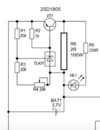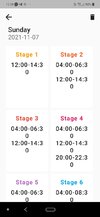Hi Guys - your help here is highly appreciated !
I have 20 x NiCad (flooded cells) of 1,2v 32Ah each, wired in series into a 24v bank. Float voltages per cell is 1.40 - 1.42 V/cell.
(I actually have 80 cells connected in 4 x 20 cells each iaw for a total of 128 Ah - charged with a 24v 3KWh Invertor )
Have looked at off the shelf BMS's but is above my pay grade - (most are designed for other batteries types and I really only need balancing)
I had a look at the attached circuit found it on YT. Can this circuit be modified to balance 1.4v cells even if I need to build 1 each for every cell.
I am aware that the cell voltage of 1.4v is low for most components to function on - which means that 24v from the bank will be needed to power the circuit
1. will need to use the bank voltages of 24 vdc via n ± LM7805 or something similar circuit to drive the BMS's for each of the cells.
2. Then a censing circuit to read the cell voltage 1.40 v adjustable (preferably multiturn pot) and use this to activate the BMS in 1. to balance each cell via a load resistor.
3. I think both circuits need to be isolated from each other by an OPTO or something.
Any ideas please share - A simple but effective circuit that I can build to balance each cell would be appreciated.
My electronics knowledge is quite limited component wise - I can build and test n circuit thanks to YT and other platforms that I have learned from ect.. But the intricacy's of component values etc. not well versed.
Thank you for your interest and help in this project
TP
I have 20 x NiCad (flooded cells) of 1,2v 32Ah each, wired in series into a 24v bank. Float voltages per cell is 1.40 - 1.42 V/cell.
(I actually have 80 cells connected in 4 x 20 cells each iaw for a total of 128 Ah - charged with a 24v 3KWh Invertor )
Have looked at off the shelf BMS's but is above my pay grade - (most are designed for other batteries types and I really only need balancing)
I had a look at the attached circuit found it on YT. Can this circuit be modified to balance 1.4v cells even if I need to build 1 each for every cell.
I am aware that the cell voltage of 1.4v is low for most components to function on - which means that 24v from the bank will be needed to power the circuit
1. will need to use the bank voltages of 24 vdc via n ± LM7805 or something similar circuit to drive the BMS's for each of the cells.
2. Then a censing circuit to read the cell voltage 1.40 v adjustable (preferably multiturn pot) and use this to activate the BMS in 1. to balance each cell via a load resistor.
3. I think both circuits need to be isolated from each other by an OPTO or something.
Any ideas please share - A simple but effective circuit that I can build to balance each cell would be appreciated.
My electronics knowledge is quite limited component wise - I can build and test n circuit thanks to YT and other platforms that I have learned from ect.. But the intricacy's of component values etc. not well versed.
Thank you for your interest and help in this project
TP




